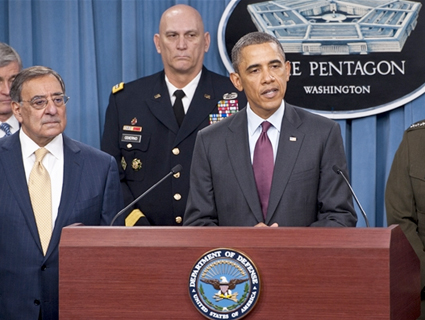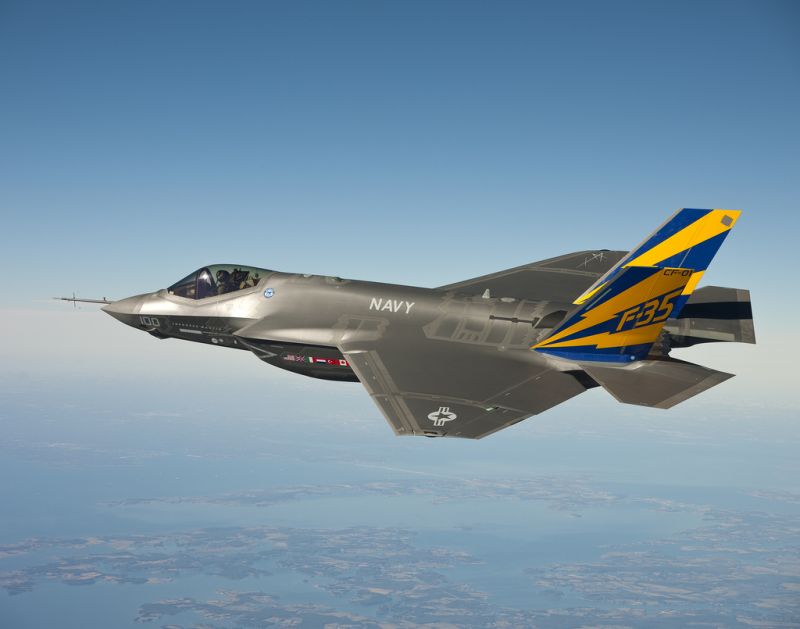
Defense Secretary Leon Panetta, Gen. Raymond Odierno, and President Obama unveil their new military strategy at the Pentagon Thursday.<a href="http://www.defense.gov/DODCMSShare/NewsStoryPhoto/2012-01/scr_120105-D-BW835-005c.jpg">DOD/Erin A. Kirk-Cuomo</a>
In an announcement long on ambition and short on specifics, President Obama and Defense Secretary Leon Panetta rolled out a new national security strategy Thursday that aims to drastically downsize the military. “[W]e have the opportunity and the responsibility to look ahead to the force we need for the future,” the president said. His plan, “Sustaining US Global Leadership,” aims to slash troops, fighter jets, and $450 million from the Pentagon bureaucracy. “Whenever possible, we will develop innovative, low-cost, and small-footprint approaches to achieve our security objectives,” the 16-page plan states.
If the strategy takes hold—and that’s hardly a given, considering how heavily the defense industry lobbies Congress—progressives may like a lot of what they see in the military’s newer, leaner look. Still, the plan leaves open the possibility that drones, contractors, and reservists will take over any gaps left in the mammoth, post-9/11 national security complex.
The strategy continues to focus on some perennial areas, like combating Al Qaeda, tracking WMDs, and maintaining a big presence in the Middle East (i.e. around Iran). But its updates would be significant:
- Nukes: Cuts to the country’s bloated nuclear weapons complex could become a reality: “It is possible that our deterrence goals can be achieved with a smaller nuclear force, which would reduce the number of nuclear weapons in our inventory as well as their role in U.S. national security strategy.”
- China and North Korea: The US will “of necessity rebalance toward the Asia-Pacific region.” In lay terms, that means going back to pre-9/11 basics: keeping a robust Navy close to China and North Korea. Obama reportedly nixed a Pentagon proposal to reduce the number of aircraft carriers from 11 to 10, a sure sign the US plans to flex its maritime muscle.
- Europe: The last remnants of America’s Cold War-era role in protecting Europe will probably be handed off to its regional allies. “Most European countries are now producers of security rather than consumers of it,” the strategy states. That could mean downsizing big US bases in Germany and removing old missiles from the landmass.
- Global policing: “U.S. forces will no longer be sized to conduct large-scale, prolonged stability operations.” Even small overseas incursions will be rarer, since “with reduced resources, thoughtful choices will need to be made regarding the location and frequency of these operations.”
- Foreign invasions: On the big-picture level, say goodbye to the long-held goal of a unilateral US force that can fight two simultaneous major ground wars. This strategy will be replaced with a “fight and deter” objective: “Even when U.S. forces are committed to a large-scale operation in one region,” the plan states, “they will be capable of denying the objectives of—or imposing unacceptable costs on—an opportunistic aggressor in a second region. U.S. forces will plan to operate whenever possible with allied and coalition forces.”
- Personnel and benefits: While cuts to personnel and administration are likely, the president says he’ll “keep faith with our troops, military families and veterans.” This could mean the administration is backing away from a controversial corporate-friendly plan to privatize soldier pensions that gained currency in the budget debate last year.
While the Pentagon presentation didn’t offer specifics on what cuts might come, the New York Times reported that the Army will lose nearly 100,000 troops, and the Air Force’s aircraft fleet will be reduced significantly—including delays on future orders of the F-35 fighter jet, one of the most expensive programs in US military history.
But the new strategy could also augur boom times ahead for contractors, spies, and drones: “In adjusting our strategy and attendant force size, the Department will make every effort to maintain an adequate industrial base and our investment in science and technology,” the plan states. “We will also encourage innovation in concepts of operation.” Such science could include unmanned aerial surveillance, which has been a favorite tool of the Obama administration; such innovations could include the expansion of contractor-managed military logistics overseas, a trend that started in the ’90s and was a hallmark of the wars in Iraq and Afghanistan.
Then there’s the issue of reserve and National Guard soldiers. Since 9/11, many of these part-time servicemembers were used overseas to take the strain off America’s overstretched active-duty troops in what came to be known as the “back-door draft.” Despite the pain this imposed on weekend warriors and their families, the National Guard brass were rewarded recently with a seat on the Joint Chiefs of Staff. Since their newfound relevance comes directly out of their usefulness in war, they might become advocates of future interventions. The new DOD strategy addresses this possibility in a cryptic line, saying that “the Department will need to examine the mix of Active Component (AC) and Reserve Component (RC) elements best suited to the strategy.”
So it appears that the plan is to shrink the military significantly—but as always, the Pentagon is hedging its bet. “Wholesale divestment of the capability to conduct any mission would be unwise,” the strategy warns, “based on historical and projected uses of U.S. military forces and our inability to predict the future.” In other words, a lot will change, unless it doesn’t.

















